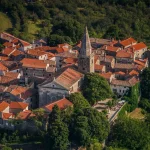ZAGREB, April 6, 2019 – A group of researchers and enthusiasts have recently joined forces in their efforts to preserve two varieties of the Istro-Romanian language that is on the brink of extinction in Istria, and published a picture book under the title “Scorica de lisica si de lupu” (“A Story about the Fox and the Wolf)” in those dialects called Vlaški and Žejanski.
The picture book was launched within the week-long campaign promoting children’s books in Rijeka, and the project about the preservation of Istro-Romanian is being led by linguist Zvjezdana Vrzić who collects material about this endangered language and is the director of the project called “Preservation of the Vlaški and Žejanski Language”. She is also president of Traces, a non-profit organisation which promotes the documentation, description and maintenance of the languages and dialects of her native Istria and Kvarner.
Also, in recent years an enthusiast Adijana Gabris has been conducting language courses for children in the Istrian villages where these dialects Vlaški and Žejanski are still spoken.
“The Vlaški and Žejanski language (Vlashki and Zheyanski, also, Istro-Romanian) is spoken in two separate areas in the northeast of the Istrian peninsula in Croatia: The first is the northern village of Žejan/Žejane, which is located in the mountains off the road leading from Rijeka to Trieste. The second comprises several villages with their adjoining hamlets south of Žejan/Žejane, around the northern edge of Čepićko Polje, just off the road leading from the Učka Tunnel to the town of Labin. The villages are Bardo/Brdo with several hamlets, such as Kostarčan/Kostrčan(i) and Zankovci, Letaj/Letaj, Nosolo/Nova Vas Sušnjevice/Šušnjevice/Šušnjevica, and Sukodru/Jesenovik,” according to the information provided on the website dedicated to the preservation of that language.
In Europe, there are 24 languages right on the brink of extinction, and three of them are from Croatia, the British Telegraph daily reported in late 2014.
Among those 24 tongues that at risk of falling out of use, the three that are from Croatia are Istro-Romanian, with an estimated 300 speakers left, Istriot (400) and Arbanasi (500). They ranked 13th, 16th and 18th respectively on a list of critically or severely endangered languages, and this ranking was topped by the Livonian language used by some 50 people in Latvia as their second language, while the last person who had Livonian as her mother tongue died in 2013, according to the report the British newspaper published in November 2014.
Istro-Romanian, an Eastern Romance language, is spoken in a few villages in the north of the Croatian peninsula of Istria, while Istriot, a Romance language, is spoken in the west of Istria. Arbanasi, a dialect of Gheg Albanian, is spoken by some 500 inhabitants in the Croatian coastal city of Zadar.
Croatian philologist August Kovačec explained in an interview to Hina a few years ago that Istro-Romanian is a variety of the Romanian language, but this dialect has not had any contact with Romanians for nearly a century.
Apart from Istro-Romanian speakers in several villages in Istria, there are also people living in New York and some other parts of America and Australia who can speak this language. Their ancestors left Istria in the 1970s due to an economic crisis.
Istriot is used in the south-western corner of the Istrian peninsula, particularly in the towns of Rovinj and Vodnjan, and its roots date back to a period before Venetian rule. Istriot has been rather italianised, according to the Croatian linguist’s explanation. The term Istriot was coined by the 19th century Italian linguist Graziadio Isaia Ascoli.
The Italian community in Istria has published dictionaries of Istriot dialect variants, Kovačec told Hina.
“Atlas of the Istro-Romanian Speeches” and “Atlas of Istriot” by philologist Goran Filipi have been published.
More news about Istria can be found in the Lifestyle section.










